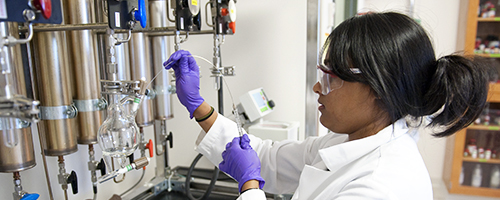Document Type
Article
Publication Date
12-14-2010
Publication Title
Chemistry of Materials
Abstract
We report an approach to the fabrication of superhydrophobic thin films that is based on the "reactive" layer-by-layer assembly of azlactone-containing polymer multilayers. We demonstrate that films fabricated from alternating layers of the azlactone functionalized polymer poly(2-vinyl- 4,4-dimethylazlactone) (PVDMA) and poly(ethyleneimine) (PEI) exhibit micro- and nanoscale surface features that result in water contact angles in excess of 150°. Our results reveal that the formation of these surface features is (i) dependent upon film thickness (i.e., the number of layers of PEI and PVDMA deposited) and (ii) that it is influenced strongly by the presence (or absence) of cyclic azlactone-functionalized oligomers that can form upon storage of the 2-vinyl-4,4-dimethylazlactone (VDMA) used to synthesize PVDMA. For example, films fabricated using polymers synthesized in the presence of these oligomers exhibited rough, textured surfaces and superhydrophobic behavior (i.e., advancing contact angles in excess of 150°). In contrast, films fabricated from PVDMA polymerized in the absence of this oligomer (e.g., using freshly distilled monomer) were smooth and only moderately hydrophobic (i.e., advancing contact angles of ̃75°). The addition of authentic, independently synthesized oligomer to samples of distilled VDMA at specified and controlled concentrations permitted reproducible fabrication of superhydrophobic thin films on the surfaces of a variety of different substrates. The surfaces of these films were demonstrated to be superhydrophobic immediately after fabrication, but they became hydrophilic after exposure to water for 6 days. Additional experiments demonstrated that it was possible to stabilize and prolong the superhydrophobic properties of these films (e.g., advancing contact angles in excess of 150° even after complete submersion in water for at least 6 weeks) by exploiting the reactivity of residual azlactones to functionalize the surfaces of the films using hydrophobic amines (e.g., aliphatic or semifluorinated aliphatic amines). Our results demonstrate a straightforward and substrate-independent approach to the design of superhydrophobic and reactive polymer-based coatings of potential use in a broad range of fundamental and applied contexts.
Volume
22
Issue
23
First Page
6319
Last Page
6327
DOI
10.1021/cm102115e
ISSN
08974756
Version
Author's Accepted Manuscript
Recommended Citation
Buck, Maren E.; Schwartz, Sarina C.; and Lynn, David M., "Superhydrophobic Thin Films Fabricated by Reactive Layer-by-Layer Assembly of Azlactone-Functionalized Polymers" (2010). Chemistry: Faculty Publications, Smith College, Northampton, MA.
https://scholarworks.smith.edu/chm_facpubs/30


